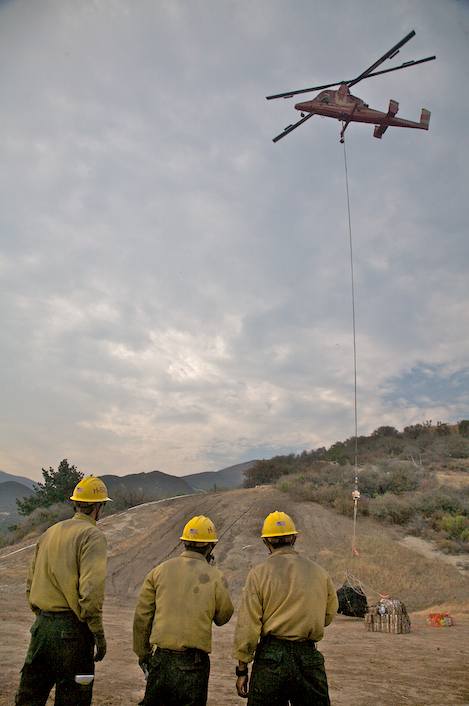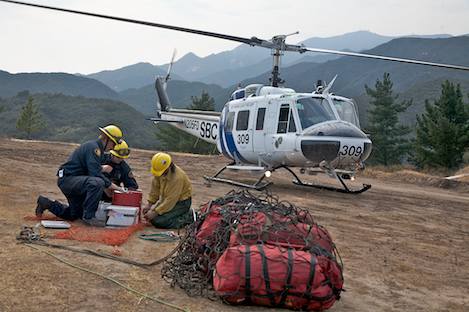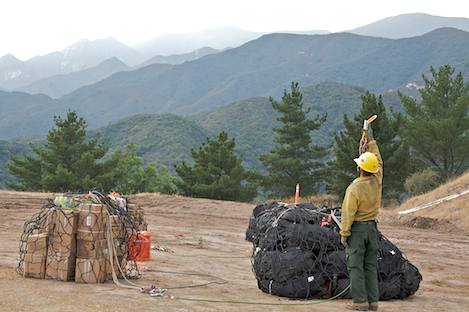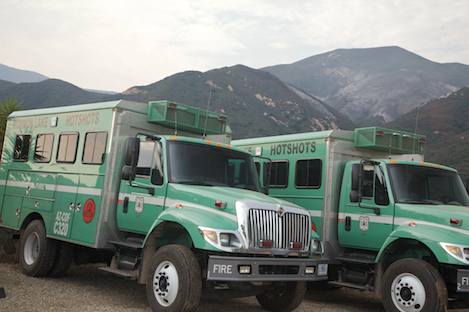Gap Fire May Soon Be Contained
Hot Weather Does Not Materialize; Hot Shots Begin to Cut Line Around Condor Peak

Mother Nature played the trickster today. While fire officials were preparing for temperatures in the high 90s and extreme fire behavior, firefighters were treated instead to temperatures in the low 80s and a relative humidity more suited to the tropics.
If you believe in miracles, your prayers were answered today. Conditions were perfect for shutting down fire activity and made it possible for hotshot crews to work directly on the fire line below Condor Peak – despite predictions that the fire would make a serious run on West Camino Cielo today that crews weren’t sure they could handle.
But this has been the norm rather than the exception with the Gap Fire. Last Wednesday evening, as the fire began to descend toward the Edison power lines, it appeared houses would burn. The next night, when the flames pushed uphill west of San Jose Creek it seemed whole communities would be consumed. This morning, given the rugged terrain and extreme weather, it seemed like firefighters’ backs were to the wall once more.

Each morning we’ve woken to the realization that we’ve survived intact; yet there has been little time to celebrate. Like a 400-meter high hurdler preparing for the Olympics, clearing one obstacle in this fire has allowed little time before the next one is directly in front of us.
Tonight, the final hurdle may be faced. Rather than raging firestorms and flare-ups by 2 p.m. today, when fire activity should have been picking up, there was almost no smoke to be seen anywhere on the western front.

This afternoon I am settled in at the top of Farren Road with Stan Smith, crew leader for the Los Prietos Hotshots. Smith is working with team members from the Santa Ynez Helitack team to load needed water, gas, chainsaw oil, food, and overnight packs to support the 120+ firefighters building hand lines directly above us near the base of Condor Point.
Crews from the El Carizo, Mormon Lake, Gila, Black Indian, Pleasant Valley, and our Los Prietos hotshots have been working at a fever pitch last night and throughout the day to circle the fire line. Tonight they will snuggle in with their gear, ready-to-eat meals, and gallon jugs of water to refresh themselves for tomorrow’s push.

“We’ve had a lot of water dropped on all sides of Condor Point,” Smith explains to me, “and the humidity feels more like Florida. We’ve got a few hot spots up there, but infrared is telling us that there aren’t any real hot spots.”
Over the next hour or so Smith’s crew spreads out in what look like giant spider webs and load the packs, water, food, and fuel into them, carefully weighing each load so the helicopter pilot will know exactly what his liftoff weight will be.
As the helicopter approaches I can see the 50-foot cable dangling that the ground crew will use to attach what looks like a half-inch-thick climber’s carabiner. While one crew member is in radio contact with the pilot, telling him the total weight, destination for the load, wind speed, and a half dozen other things that escape me, another crew member stands near the load and raises the carabiner high so the pilot will know exactly where to hover. Then everyone retreats to a safe place behind the Los Prietos Hotshot truck while the helicopter descends to the pickup spot. Once in place the crew member scurries back out, hooks the clamp onto the carabiner, and then scampers back to safety. Seconds later the helicopter is on its way to deliver the gear a thousand feet above us.

This same set of procedures is repeated five more times until all of the equipment, personal gear, food, and water to support a crew the size of a small village is delivered halfway up to the top of some of Santa Barbara’s wildest country.
Smith estimates it will take three to four days at most for the crews to build hand line around the fire perimeter near Condor Point – that is, if the fire continues to cooperate. It appears that it will.
With most of the perimeter now close to control the majority of supression resources can be focused on supporting the hotshots to close off this last section of open fire line; the most encouraging development today. Mother Nature, I hope, has no more tricks up her sleeve.
Just a week ago I was watching flames pour down off the steep mountainsides behind Goleta, wondering if our community is about to be wrenched apart by the oncoming flames. As I leave the hills above Farren Road tonight there is much for which to be thankful. Mostly it is for the thousands of firefighters who’ve been with us to hold those flames back, but also the fact that in the face of apparent overwhelming catastrophe, by the end of the weekend the danger may be behind us — without having lost a a single home.



